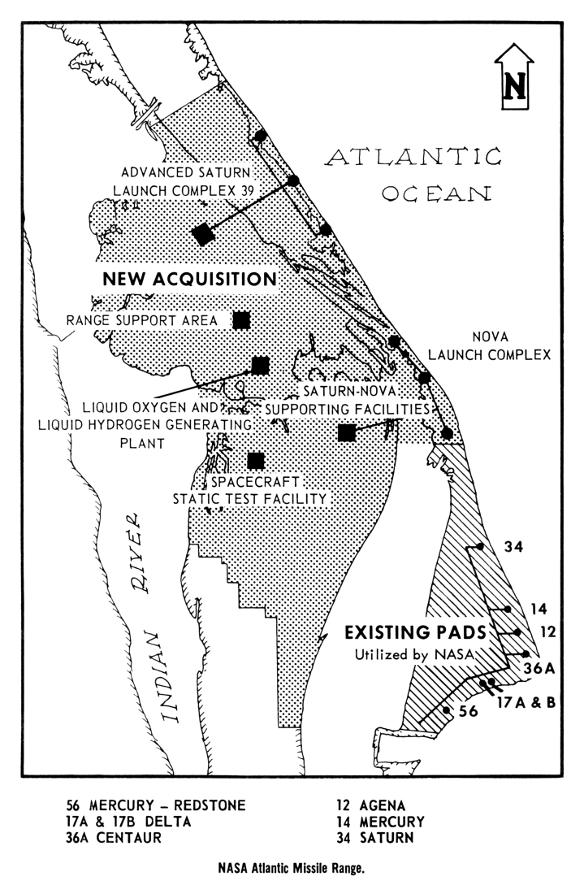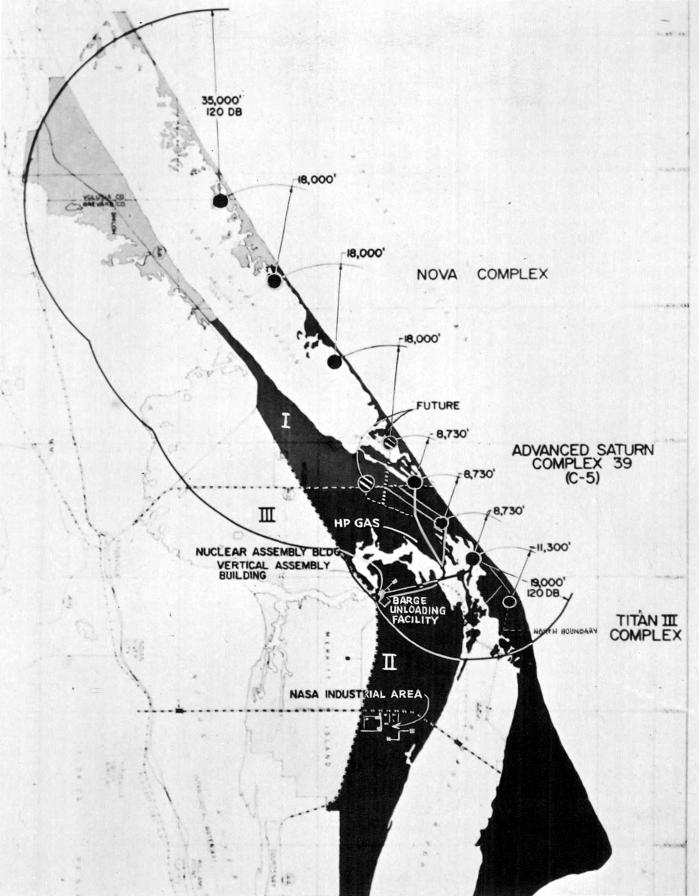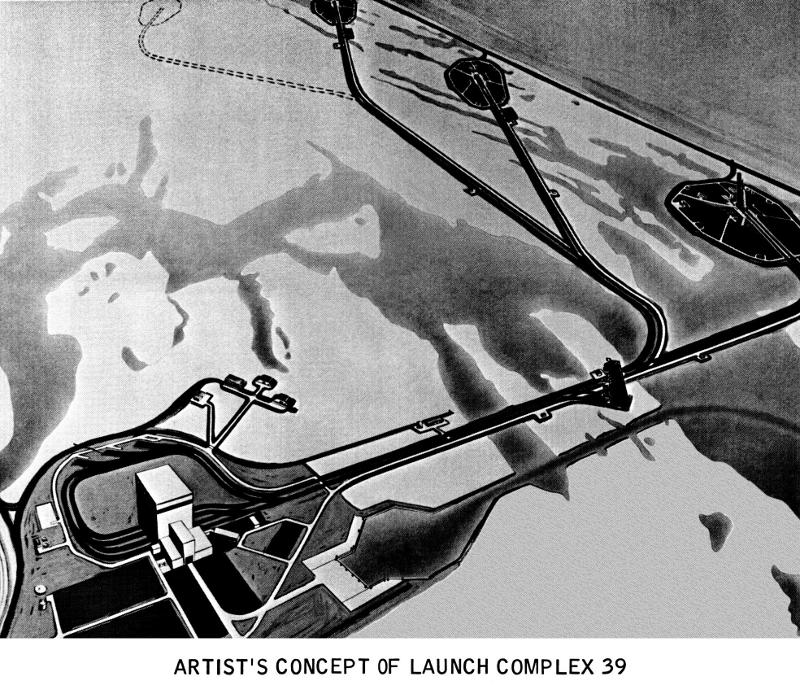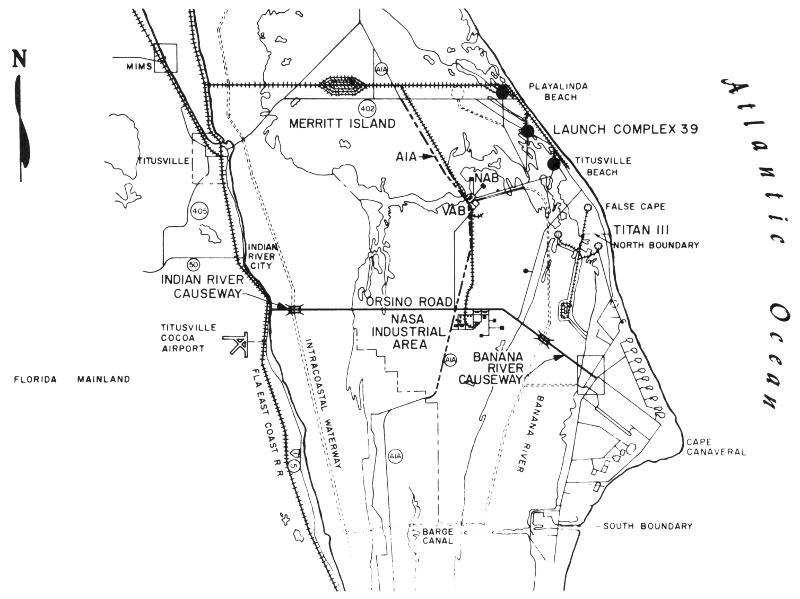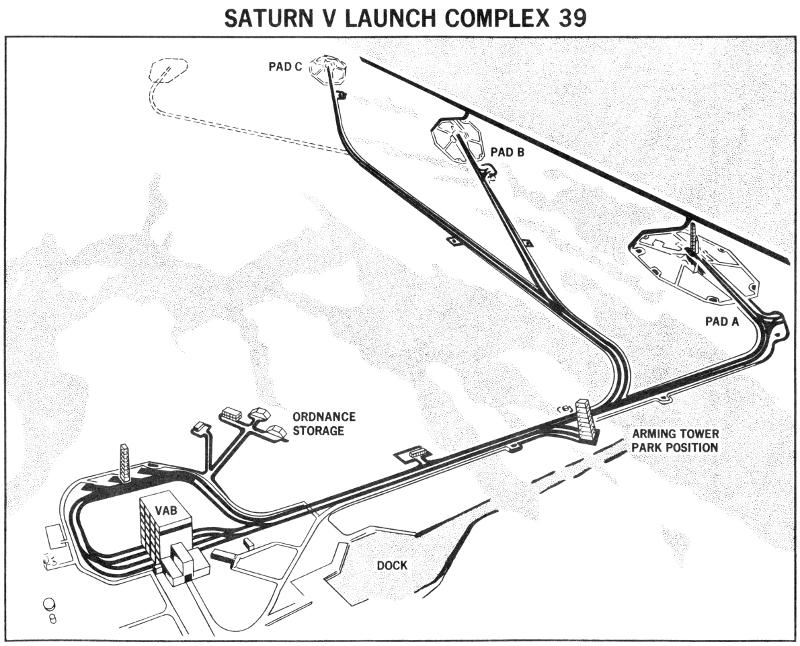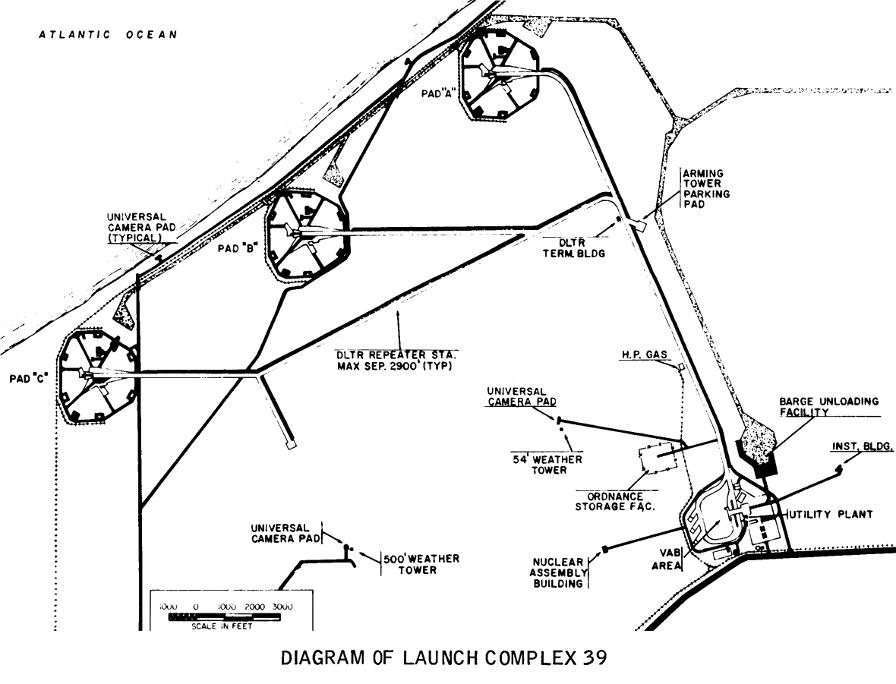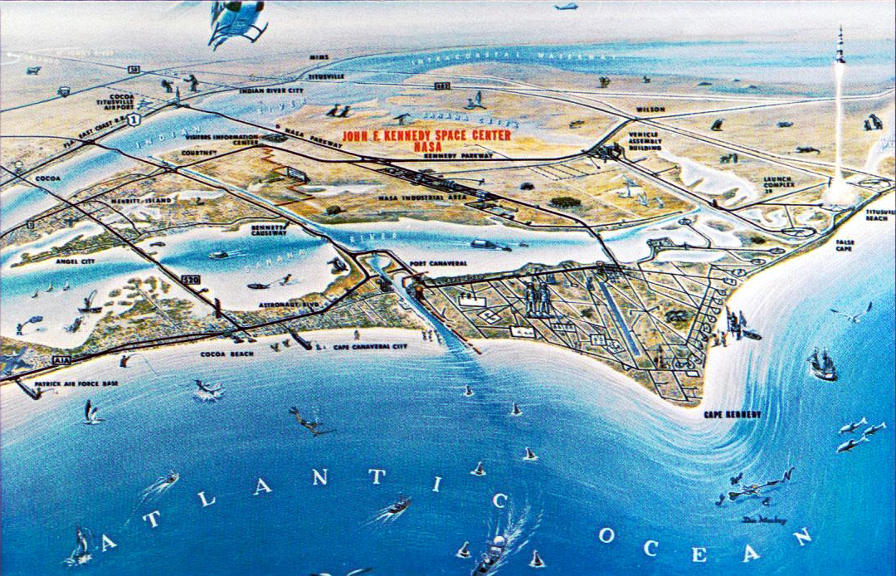Launch Complexes 39A, 39B, 39C, and 39D
When Launch Complex 39 was initially being designed, it was not yet decided exactly how the U.S. would be getting to the moon, how many launches would be required for a lunar mission, or how large the rockets would be. As such, the LC-39 designers erred on the side of caution, designing a launch complex which would be able to accommodate any reasonable launch rate and could be expanded for an even higher capacity.
Prior to July 1962, the lunar mission "mode" had not yet been decided. The leading candidate was earth-orbit rendezvous, where two or more rockets would be launched, rendezvous in earth orbit, assemble the lunar spacecraft, and proceed to the lunar surface; this method would require a fairly high launch rate per mission.
I have a pamphlet dating back to perhaps early 1963, which was a time of real excitement and optimism about the program. The pamphlet touts that "[f]our launches of the Saturn V are currently scheduled for 1966, and six are planned for 1967." After the first launch in "early 1966", operational launches would occur "about two years later"; goodness only knows what the operational launch rate would be.
With such a high launch rate, a large launch complex with several launch pads would certainly be required, and this pamphlet shows such an early concept, where LC-39 had four launch pads (adding LC-39C and LC-39D to LC-39A and LC-39B, the two pads which were actually built). Note the "kink" along the route to the north-most pad; presumably, this would allow the eventual addition of yet another launch pad! LC-39E, anyone?
Click image for a 1918x1232 pixel version of this image in a new window.
From page 4 of The
Saturn V Apollo Moon Rocket.
Scan, cleanup, and extraction by heroicrelics.org.
I haven't found anything indicating when LC-39D was first proposed. The following very early diagram, dating back to the second half of 1961, generically shows a building (presumably the VAB) and three launch pads, without the crawlerways (not surprising since, in 1961, it had not yet been decided how to transport the assembly space launch vehicle from the Vertical Assembly Building to the pad; the publication from which this diagram was scanned also shows the rocket being transported to the pad via a rail system). While the two northern-most pads are located approximately where pads 39A and 39B were eventually built, this diagram also shows a pad to the south of what became the part of crawlerway leading out of the VAB:
Click image for a 2876x4410 pixel version of this image in a new window.
From page 126 of Sixth Semiannual Report to Congress July 1 - December
31, 1961. Located in the Saturn V Collection, Dept. of Archives/Special
Collections, M. Louis Salmon Library, University of Alabama in
Huntsville. Also available
electronically.
Scan, cleanup, and extraction by heroicrelics.org.
But once LC-39D was proposed, it didn't take long to produce a diagram depicting LC-39E. This February 1963 diagram shows LC-39D and LC-39E being shown in dotted lines and labelled "Future":
Click image for a 1862x2637 pixel version of this image in a new window.
From page 57 (p. 66 in the PDF) of NASA-Industry Program
Plans Conference, Washington, D.C., February 11-12, 1963.
Extraction and cleanup and by heroicrelics.org.
In addition to the Saturn V (at the time known as the "Advanced Saturn" or the "Saturn C-5"), it also shows the proposed Titan II complex on Cape Canaveral to the south and the proposed Nova launch complex to the north.
The diagram shows the distances between the various pads. The Saturn V pads were designed (and LC-39A and LC-39B were actually built) to be 8,730 feet apart, to limit damage should there be an on-pad explosion. The three Nova pads were planned to be 18,000 feet apart, presumably because the Nova rockets were expected to be much larger and have a larger explosive potential.
I have additional diagrams, below, which label the pads and show Pad 39D due west of LC-39C, which would mean that the northern-most emplacement would have been Pad 39E.
As time went on and lunar orbit rendezvous (in which a single rocket launched two, specialized spacecraft, one which was optimized to actually land on the moon and a second spacecraft, the only one which would carry the heavy heatshield required for Earth reentry, which would remain in lunar orbit and await the lunar module to rendezvous with it after leaving the lunar surface) was chosen, plans for five pads in the launch complex were scaled back to meet the projected need (and budget realities).
This (oddly-cropped) diagram shows a scaled back LC-39: It still shows (most of) Pad C but Pad D is depicted with just a dotted line and Pad E is entirely absent. This diagram is taken from a paper delivered in March 1963, still early enough to realistically expect three pads. The paper notes that "room [is] allowed for future expansion" because
It is difficult, if not impossible, to predict the exact needs for launch facilities past the next few years, but Complex 39 is inherently flexible in regard to additions. Three launch pads are planned for initial construction; however the assembly area for vehicles can service more than that and it can be expanded if necessary. Since so few pads are required at first [because of the reduced time-on-pad resulting from the LC-39 "mobile concept"], real estate is conserved for future pads within a convenient distance of other existing launch support facilities.
Click image for a 1968x1707 pixel version of this image in a new window.
From page 6 of "Saturn V Checkout Facilities at Merritt Island Launch
Area", NASA document id 19630012154, which no longer appears to be
available on the Internet.
Extraction and restoration by heroicrelics.org.
So, it is difficult to determine how certain it ever was that any pads in excess of Pad C would be constructed or if Pads D and E were always just part of some "future expansion" allowance, although this crop from a larger Merritt Island Launch Area diagram circa December 1963 has what appears to be the crawlerway for at least one additional pad, with Pads A through C specifically labelled (although with Pad C oddly cropped again):
Crop from NASA photo S63-23618.
Click image for additional information about this image in a new window.
Another diagram from December 1963 shows the locations of Pads A through C, plus Pad D as a dotted line:
Click image for a 3017x2260 pixel version of this image in a new window.
From page 240 of Moonport: A History of Apollo Launch Facilities and
Operations. Located in the Raynor Memorial Libraries,
Marquette University. Also available in electronic format.
Scan and cleanup by heroicrelics.org.
There seem to be a goodly number of diagrams showing LC-39D drawn with a dotted line. This diagram was taken from a document dated February 1966. As SA-500F was rolled out in May 1966, this was far too late to still show to even Pad C (unless perhaps if it were depicted with a dotted line), much less Pad D. In fact, the same document from which I took this diagram also has a similar diagram, but showing LC-39 as built, with only Pad A and Pad B.
Click image for a 4763x3844 pixel version of this image in a new window.
From page 139 of Saturn S-IVB Training Graphics: KSC Familiarization,
Course No. XY-203 (February 1966). Located in the Mauldin collection,
Dept. of Archives/Special
Collections, M. Louis Salmon Library, University of Alabama in
Huntsville.
Scan and cleanup by heroicrelics.org.
The March 1963 paper above also contains a three-pad depiction of LC-39, with no dotted-line version of Pad D:
Click image for a 2361x1802 pixel version of this image in a new window.
From page 8 of "Saturn V Checkout Facilities at Merritt Island Launch
Area", NASA document id 19630012154, which no longer appears to be
available on the Internet.
Extraction and restoration by heroicrelics.org.
While LC-39 was still to have three pads when construction began (see page 247/page 268 of the PDF) and there are photos of a warning system which included Pad C, Pad C was never to be. However, Pad C did earn the honor of launching the first Saturn V (if only on the the cover of Life magazine):
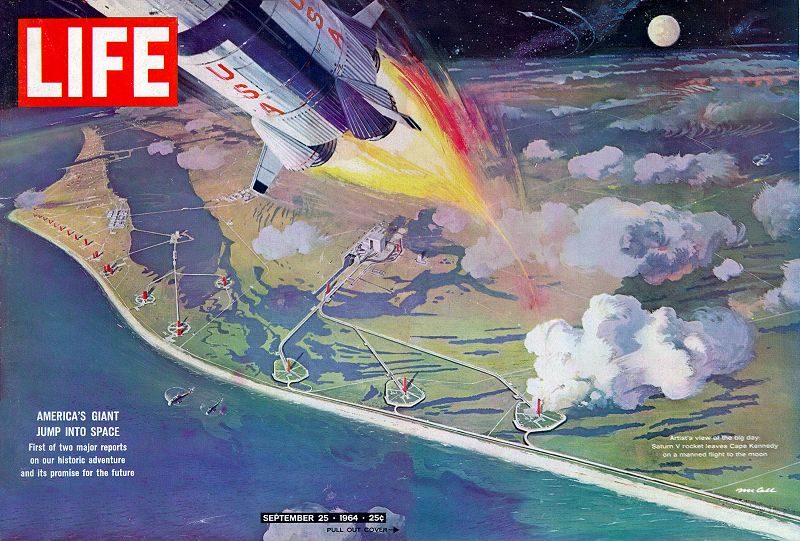
Cover of the September 25, 1964 issue of Life magazine.
Photo courtesy RetroWeb
This undated postcard also shows LC-39 with three pads and a Saturn V launch, with Pad B as the launch site this time (although, with the Spanish galleon just off-shore, it seems more likely that the launch would have been scrubbed or at least delayed):
Click image for a 1080x694 pixel version of this image in a new window.
From an eBay auction.
Cleanup by heroicrelics.org.
These discussions of LC-39D, with Pad D being the north-most, do raise some questions. Apparently, standard Missile Test Center practice was to designate the launch pads from north to south, with "A" being the north-most. When construction began on the the current Pad A (i.e., the south-most pad), it was at the time designated "Pad C", in accordance with this practice (the pads were redesignated with Pad A being the south-most pad in January 1963). So, it would seem that plans for Pad D must have been dropped before construction began (since the south-most pad was initially designated "C"), and the south-to-north progression of pads should have gone no farther than Pad C. The appearance of Pad D may simply reflect wishful thinking.
Of course, Apollo 4, the first Saturn V launch, didn't actually occur until November 9, 1967 (NASA didn't quite meet the orange pamphlet's prediction of four launches in 1966 and six in 1967). Other than 1969 (which did see the launch of four Saturn Vs), the launch rate was much lower, with only one or two per year throughout its 1967-1973 operational period. Of the two launch pads at LC-39 actually built, Pad A saw the most use, with Pad B being used only once (for Apollo 10) during the main Apollo program.
Click image for a 5478x4153 pixel version of this image in a new window.
From page 20 of Saturn S-IVB Training Graphics: KSC Familiarization,
Course No. XY-203 (February 1966). Located in the Mauldin collection,
Dept. of Archives/Special
Collections, M. Louis Salmon Library, University of Alabama in
Huntsville.
Scan and cleanup by heroicrelics.org.
After Apollo proper, LC-39 was used to launch Skylab (Pad A used to launch the Orbital Workshop and Pad B to launch the three manned missions) and the Apollo-Soyuz Test Project. The pads were subsequently converted for Shuttle use, with Pad A launching 80 Shuttle missions and Pad B 53. Pad B also launched the Ares I-X rocket, before Barack Obama cancelled Project Constellation.
Post-Shuttle, SpaceX entered into a 20-year lease agreement for Pad A. Pad B will be used with the Space Launch System (SLS), assuming that it survives the whims of the next presidential administrations.
In July 2015, NASA completed construction of LC-39C, a much smaller launch pad located adjacent to LC-39B. Measuring only 50 by 100 feet, LC-39C was equipped to provide commercial customers with a "universal propellant servicing system" (consisting of liquid oxygen and liquid methane) and support launch vehicles and associated launch mounts weighing up to 132,000 pounds when fully fueled (YouTube video, photos of facility and ribbon-cutting ceremony).
As of February 2020, it appears that no launches have yet to take place from LC-39C, and while LC-39B is listed as a "physical asset" on the Kennedy Space Center Partnerships Website, there doesn't seem to be any trace of LC-39C, so the pad's future seems to be uncertain.


